One of the band’s bigger shows of the year was what
is remembered as ‘their first paying gig’ – they
received $25 for this one. Dick Citroen was dealing
with a number of people 'Stateside' as well as
working with the Brass Union. He linked up with a
Grand Rapids Michigan boy, Del Shannon – one of
the bigger acts of the time. Del was coming to
Canada and because it was so costly to move entire
bands across the border back then, he was looking
for a local band to back him. Dick suggested the
Brass Union to his manager, but with one condition:
that the band would receive billing on the show. Dick
wanted the show to read: “Del Shannon, featuring
the Brass Union”. He was very particular about this,
even the size of the lettering on the posters. "We
received a song list and some basic charts only a day
or so before Shannon showed up and we scrambled to
learn them as best we could and played to a packed
house at The Kiwanis Boy's Club in Hamilton. This was a
very big deal for us at the time", recalls Cliff Hunt. The band did so well, that many in
attendance thought that the Brass Union was Del’s regular band from the U.S. – somewhat
impressive for a band less than a year old.
The band spent the rest of the fall of 1967 working in the new guys, getting different
promotional items together and continuing to play high schools, festivals, parties and
various other things in and around the area. By year’s end, the Hamilton Spectator (the
major newspaper in Hamilton) published a ‘Top Bands in the Area’ poll with the Brass
Union coming in third behind the Roots of All Evil and the Jameson Roberts Blues Band –
quite an accomplishment for a band, only just completing their first year.
When you’re a high school student in the music program, a little
success goes a long way, and the reception that the Aldershot High
School students gave the Hulse’s Heroes Christmas production of
1966 was no exception. Nine guys from that production decided to
put together a band, and off they went to Cliff Hunt’s basement to
begin work. With Cliff’s father, Cliff Hunt Sr., being a career
musician, trying to put a band together in the family basement
seemed like a natural fit. In early January of 1967, they formed a
band they called “the Fourth Hyrd” – a reference to Woody
Herman’s First Herd band (1936-46) and his Second and Third
Herd bands (from 1947 on).
The first two songs the boys learned were: “Watermelon Man”, a
jazz standard by Herbie Hancock and “On Broadway”, a 1963 hit by
the Drifters. The rest of the songlist was built around the Motown
hits coming out of Detroit that year: Wilson Picket and Sam & Dave
songs, and other popular hits of the time – Happy Together, by the
Turtles; Mitch Ryder hits – songs that are still played in cover bands
today, but were top 40 hits, at the time. What made this band
different musically from most others forming during this time was the
full four-piece horn section. Kids were starting to realize how
dynamic rock music would sound with a full horn section. As I
mentioned, Chicago Transit Authority, Blood, Sweat and Tears and
also Electric Flag formed that same year, but they had just barely
released their first albums. And it wasn’t until the following year that
Tower of Power were formed, and a year after that, in 1969, that we
saw the Canadian bands Lighthouse and the Ides of March. There
were a lot of bands forming during this time. I was a part of a couple
of them myself in 1967 – bands working out of the adjoining town of
Hamilton.
“I remember we played a house party in Burlington one night, early in
the year. We only had a few songs, so there were a lot of repeats”,
said Cliff Hunt, with a laugh. “We put a nine-piece band into
someone’s home for a party. It was crazy. The cops raided the place
and it made the papers.”
Word spread quickly about this new band in the Burlington area and
they began playing the local high schools: Central, Nelson, M.M.
Robinson, and of course, Aldershot High. They spent the spring of
1967 working on their songlist,
playing parties, special events,
high schools, anywhere where
they could get gigs. By the
end of the year, they had
played every major high school
in the area and had branched
out and were playing high
schools in Hamilton and other
nearby communities.

Aaaahh, yes ... 1967. What a year for the
world. What a year to be a high school kid
putting a 'band' together -- they were just
called 'bands' back then, not horn bands, or
rock bands, or show bands -- although this
band would turn out to be all of these. The
boys from Aldershot High School picked a
very good time to put together their 9-piece
band, with the beginnings of two other, soon-
to-be-famous bands that year: Chicago
Transit Authority and Blood, Sweat and
Tears. As a horn player from another part of
the city, I can remember sitting with my horn
and a couple of buddies, in someone's
basement, playing for hours and hours, as
we learned our 'chops' to that first Blood,
Sweat & Tears album.
In the world, the race riots continued, hitting
very close to home in Buffalo, N.Y. during the
summer. The Vietnam War protests
continued in full force, fueled by reports that
the US had bombed a city of civilians and the
drafting of a man named Cassius Clay. 1967
saw the Monterey Festival, the Arab-Israeli
War, the Beatles release of their Sgt.
Pepper's album, the first Communist China
H-bomb test, the debut of Rolling Stone
magazine, the death of Otis Redding in a
plane crash and the emergence of San
Francisco's Haight-Ashbury district as the
centre of the "Summer of Love". Yes, it was
a good year to be putting together a band.



The 1967 Riots in Buffalo, N.Y.
June 26 - July 1, 1967
KKIS 990, Pittsburg
Bill Plummer - March 1967
1967

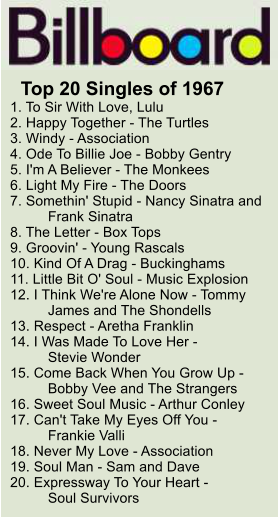
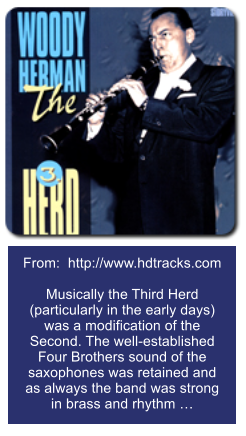
The
FOURTH
HYRD





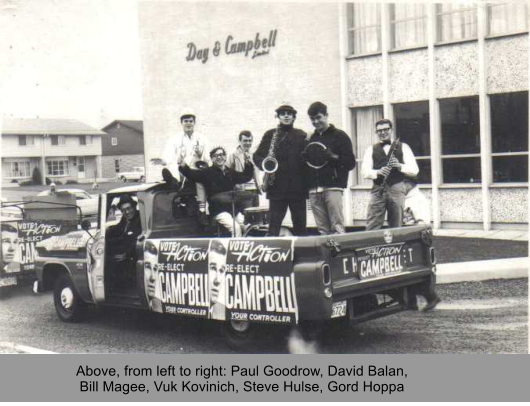
One of the early photoshoots on the grounds of the
Royal Botanical Gardens in Hamilton, ON
Emerging from that first Hulse’s Heroes production, the roots of the band were not only
musical, but theatrical – a ‘double focus’ that would lead to a great deal of their early
success, but more immediately, it opened the door for one of those chance meetings
that would change the band completely. Through a number of different connections at
Aldershot High School, a friend of Vuk Kovinich (the lead guitarist and appointed leader
of the band) approached a couple who lived in the area who had just emigrated from
Britain a few years before. Dick Citroen and his wife Terri Anders (her stage name)
were both part of the thriving British music scene of the mid-60’s – Dick, in many
aspects, but most notably as the drummer for the group Tommy Steele and the
Cavemen. Terri Anders was a professional singer/actress herself, working both in
Britain and in Canada.
“Back in early 1967, Dick and I were approached by someone from Aldershot High to
listen to a young group made up of mainly high school students from the area. We
were both in the business and could spot raw talent when we saw it”, said Terri recently.
“So we went along to a church basement (I think it was East Plains Church), where we
first encountered The Fourth Herd. I remember sitting watching and listening to this
group of earnest kids playing their hearts out for us. Immediately, both Dick and I knew
we were seeing something special in the making.”
Soon, the two became regular attendees of the band practices and before long, Dick
Citroen became the band’s first manager. “I took these raw talent high school kids and
taught them how to be professional musicians”, recalled Dick. “They learned basic
stagecraft and how to present themselves.” And this began the changes, early in 1967,
that would change everything about the nine boys that played in the back of Archie
Campbell’s truck in the pictures above, and would make this band ‘different’ from all the
other good bands that were forming during this time.

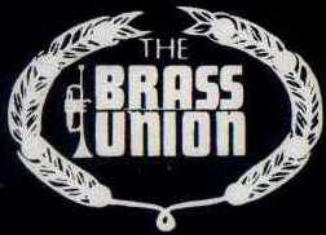


The first thing to be done was change the name of the band. They wanted a name that
was more representative of the dynamic nature of the horns. Borrowing an idea from
Gary Puckett and the Union Gap, one of the top bands of the time, Mike Lansbury (the
band’s lead singer) suggested the name ‘Union Brass’. After a short discussion, the
name Brass Union would become the band’s new name. With the name, they wanted
to design a logo to identify the band. Again, borrowing from one of the top businesses
of the time, A & M records, and incorporating ideas from other parts of the arts, the
band designed their new logo shown to the left. From now on, this would be on all
promotion and anything to do with the band.
Throughout the spring of 1967, the band continued to work on their
songlist and play locally. Putting a four-piece horn section into the
rock and Motown music that was around at the time was not as easy
a task as one would imagine. Four individual horn players are not
like a piano or a guitar where multiple fingers can be put down on a
keyboard. They needed to be co-ordinated, or ‘arranged’ and that
was the work of Darrell Nameth, the band’s saxophonist. Not only
was he a fine horn player, but he was also the leader of the Aldershot
High Junior Band in his senior years at the school. With Darrell came
excellent arrangements for the four horn players. I’d heard of the
work of the Brass Union myself as a horn player in the next town
over, and I’d heard that they were a rather good band.
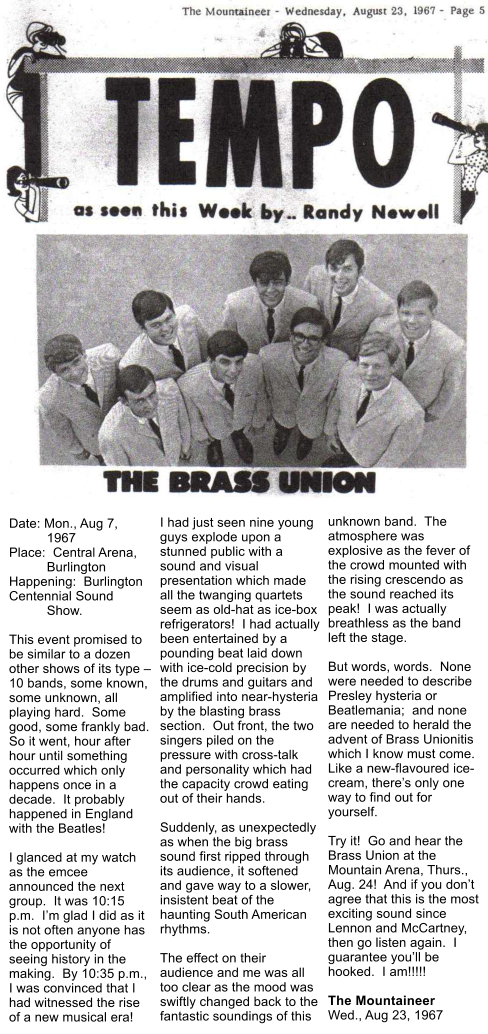
Arguably, the biggest ‘event’ for the Brass Union in 1967 was hearing about
a Battle of the Bands at Central Arena in Burlington later in the summer,
which they decided to enter. All the top local bands in the area would be
there that day.
“We worked on their presentation, choreography (staging), clothing and
singing (which was mainly my department)”, said Terri. “There was an
upcoming band competition and it was decided to improve their stage show
in order to appear in the program. They all went to Toronto and were fitted
with matching sear-sucker jackets (wouldn’t crease), over black dress
pants, black shoes, white shirt and tie.” They had two separate outfits, one
with a dark jacket and the other with a lighter-coloured jacket.
“In Britain, you couldn’t join the Musician’s Union unless you had a ‘tux’.
You obviously needed to have talent, but appearance was just as important
as performance”, said Dick Citroen recently. And this attitude of
professionalism in stage attire was instilled into the boys in the band. They
were given 24 minutes of time for their act and they rehearsed a show that
was exactly 24 minutes in length. They hired Bill Hughes and George
Hamor as their production crew and rented a van for all their equipment.
“I told them that the only thing that they were to carry into the competition
was their own instrument. All the rest was to be done by the production
crew. It’s just the way it was done back then”, Dick went on. “I remember
when we pulled up to the back door of the arena that day, and Bill and
George opened up the back doors of the van to wheel out amps and racks
of clothing, that four of the bands quit the competition before it had even
started. The music had to be there, but that day, it was also about
appearance.” I can remember joining the band a few years later and not
only having to learn all the music, but also a large amount of
choreographed dance moves – something not all that common with local
bands at this time.
“For the competition, it was decided that one of the numbers would be
Mitch Ryder’s “Sock It To Me Baby”. The band stood with their backs to the
audience. Then Mike, the lead singer, would suddenly turn his head
around and ask: “Does anyone here know Mitch Ryder?” With that, the
whole band turned to the audience playing the number. The effect on the
people was electric !! I have never forgotten that”, said Terri, recently.
The Brass Union ‘won big’ that day, walked away with their $100 prize (a
lot of money in those days) and they were on their way. And in doing so,
they also impressed a number of people, one of which was a local reporter
in attendance who wrote the article to the left.
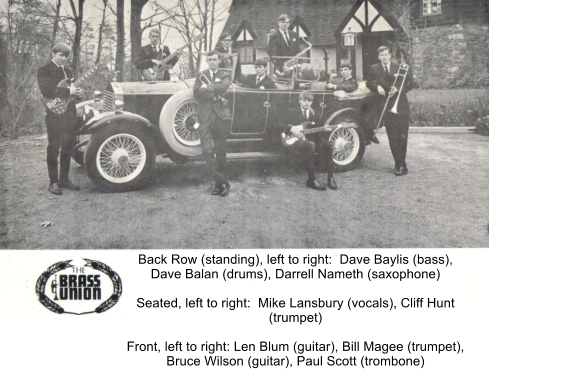

After the success of the Battle of the Bands, Dick started to market
the band. When it was realized that the band was to become a bit
more than just an enjoyable weekend hobby, the band went
through the first of its many personnel changes. The guys sat
down and had one of those all-important ‘band meetings’. It was
the end of the summer, the end of high school for a number of the
guys, and some wanted to stay serious with their music and some
had other plans in mind for themselves for after high school. It was
at this point that the Goodrow brothers, Paul and Dave, decided to
leave the band, following a few months later by Vuk Kovinich, who
was about to move out of the area. Paul Goodrow was replaced by
Paul Scott on trombone. His brother Dave was replaced by Dave
Baylis, on bass guitar. Vuk Kovinich was replaced by Len Blum on
lead guitar, a Hamilton boy from Westdale High School.
Dick continued to work with the band from a management
perspective, improving their visual show, instilling professional
attitudes and booking the boys into progressively better venues as
the year went on. At one point he hired a professional
photographer named Jim Fish to take promotional pictures of the
band which he would make into a full promotional package by early
in the following year. The band built their own stages, large circular
sheets of plywood on bases of 2” circular pipe, screwed into
flanges attached under the plywood. There were four horn stages,
about a foot off the ground and two feet in diameter; two stages for
Bruce on guitar and Dave on bass, about double the diameter and
about two and a half feet off the ground. And finally, there was the
drum stage, in two pieces screwed together, in the centre about
five feet off the ground. Curtains were made in 3 different colours
(yellow, red and blue) to cover the legs on the stages. Len on
guitar and singer, Mike, were on ground level as the two main ‘front
men’ of the band. “We wanted to hide the amps”, said Dick. “The
visual presentation was very important to us.” The staging was one
of the things I remembered most about Brass Union as I made my
way through other bands in the Hamilton area. They added a full
light show, complete with strobes, black lights and flash pots, with
Bill Hughes running it from beside the sound board. And George
Hamor ran the board and controlled the sound and the volume of
the band from there. All these things were rather innovative for the
year 1967 – at least, around the Hamilton/Burlington area.


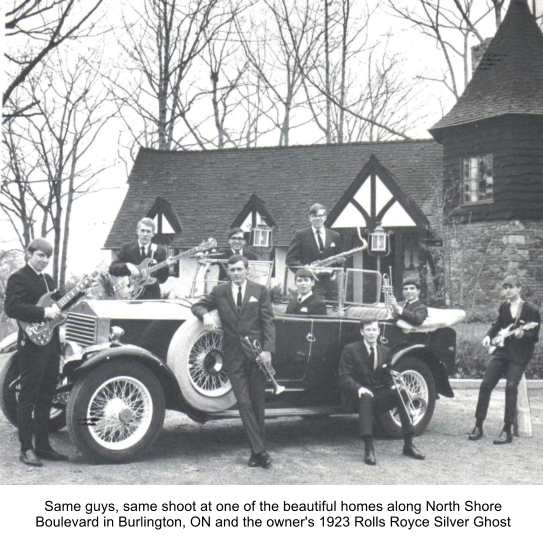
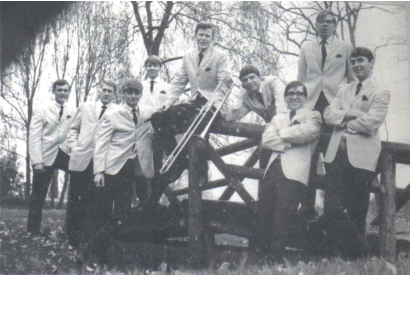
Del Shannon's 'other' hit










Music from the 1967
Brass Union songlist









